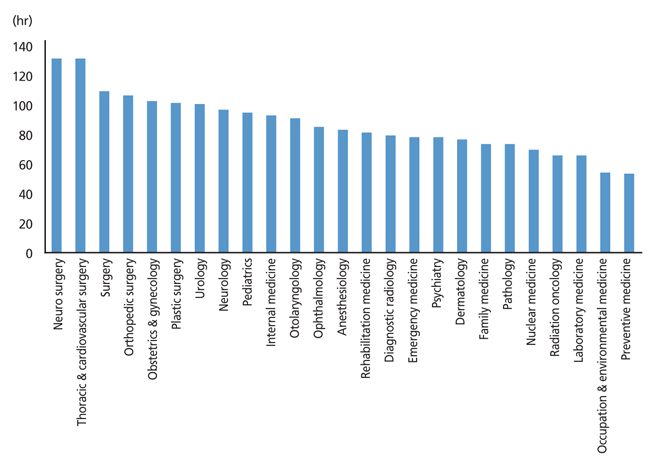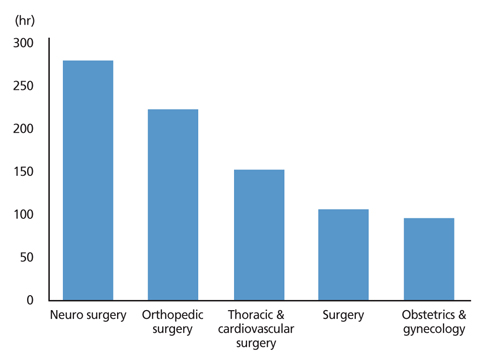A survey on training and working conditions of residents in 2015
- Affiliations
-
- 1Research Institute for Healthcare Policy, Korean Medical Association, Seoul, Korea. philiakjs5426@kma.org
- KMID: 2195147
- DOI: http://doi.org/10.5124/jkma.2015.58.12.1179
Abstract
- The objectives of this study are (1) to examine the training and working conditions of residents after revision of the 'Regulations on Specialist Training and Accreditation,' (2) to determine the causes of problems with these training and working conditions, and (3) to seek improvement in these conditions. A questionnaire survey was conducted over two weeks. A total of 10,768 respondents and 1,793 valid responses were analyzed. Although revised regulations had been implemented, training conditions did not appear to have undergone any improvements. 52.9% of residents work over 80 hours per week and 27.1% respondents exceeded 100 hours per week. 76.9% of respondents indicated that they exceed the maximum continuous training time of 36 hours. 64.5% of respondents said their emergency room training time was over 12 hours. 25.4% of respondents' duty days exceeded three days a week. 34.7% of respondents said that they had less than three days off per month. The proportion of those with annual leave under 14 days is 70.2%. For substantive improvements in training and working conditions, new plans must consider practical factors in the implementation of improvements. This requires a governance structure based on participation, and an independent, objective training evaluation organization should be established to perform a reliable assessment. Above all, the government financial compensation plan must prepare for improving the training environment.
Keyword
MeSH Terms
Figure
Cited by 5 articles
-
Implementation of a resident night float system in a surgery department in Korea for 6 months: electronic medical record-based big data analysis and medical staff survey
Hyeong Won Yu, June Young Choi, Young Suk Park, Hyung Sub Park, YoungRok Choi, Sang-Hoon Ahn, Eunyoung Kang, Heung-Kwon Oh, Eun-Kyu Kim, Jai Young Cho, Duck-Woo Kim, Do Joong Park, Yoo-Seok Yoon, Sung Bum Kang, Hyung-Ho Kim, Ho-Seong Han, Taeseung Lee
Ann Surg Treat Res. 2019;96(5):209-215. doi: 10.4174/astr.2019.96.5.209.Survey on the Environment and Condition of Korean Psychiatric Residents from 2016 to 2017 Years
Jee Hoon Kim, Yeong Gi Kyeon, Jong-Woo Kim, Hong Seok Oh, Sang Min Lee, Jeong Seok Seo, Sung-Won Jung, KangUk Lee
J Korean Neuropsychiatr Assoc. 2019;58(3):216-229. doi: 10.4306/jknpa.2019.58.3.216.Will the year 2016 augur well for better patient safety and health of residents in Korea according to the enactment of the Act for improving the resident training environment and enhancing resident’s status?
Sun Huh
J Educ Eval Health Prof. 2016;13:2. doi: 10.3352/jeehp.2016.13.2.Changes in the working conditions and learning environment of medical residents after the enactment of the Medical Resident Act in Korea in 2015: a national 4-year longitudinal study
Sangho Sohn, Yeonjoo Seo, Yunsik Jeong, Seungwoo Lee, Jeesun Lee, Kyung Ju Lee, Sun Huh
J Educ Eval Health Prof. 2021;18:7. doi: 10.3352/jeehp.2021.18.7.Changes in the Health Indicators of Hospital Medical Residents During the Four-Year Training Period in Korea
Ji-Sung Ahn, Seunghyeon Cho, Won-Ju Park
J Korean Med Sci. 2022;37(25):e202. doi: 10.3346/jkms.2022.37.e202.
Reference
-
1. Research Institute for Healthcare Policy. Korean Medical Association. 2014 Annual report on membership statistics Korean Medical Association. Seoul: Research Institute for Healthcare Policy, Korean Medical Association;2014.2. Ulmer C, Wolman DM, Johns MM. Institute of Medicine. Resident duty hours: enhancing sleep, supervision, and safety. Washington, DC: National Academies Press;2008.3. Jagsi R, Kitch BT, Weinstein DF, Campbell EG, Hutter M, Weissman JS. Residents report on adverse events and their causes. Arch Intern Med. 2005; 165:2607–2613.
Article4. Landrigan CP, Rothschild JM, Cronin JW, Kaushal R, Burdick E, Katz JT, Lilly CM, Stone PH, Lockley SW, Bates DW, Czeisler CA. Effect of reducing interns' work hours on serious medical errors in intensive care units. N Engl J Med. 2004; 351:1838–1848.
Article5. Accreditation Council for Graduate Medical Education. Resident duty hours in the learning and working environment comparison of 2003 and 2011 standards [Internet]. Chicago: Accreditation Council for Graduate Medical Education;cited 2015 Oct 8. Available from: http://www.acgme.org/acgmeweb/Portals/0/PDFs/dh-ComparisonTable2003v2011.pdf.6. British Medical Association. European working time directive [Internet]. London: British Medical Association;cited 2015 Oct 8. Available from: http://bma.org.uk/support-at-work/ewtd.7. Kyoung MB, Kim YY, Han BD, Jo TH. A survey on training and working conditions of residents. Seoul: Research Institute for Healthcare Policy, Korean Medical Association;2014.8. Song MJ, Kim YJ, Lim SM. A survey on training and working conditions of residents in 2014. Seoul: Research Institute for Healthcare Policy, Korean Medical Association;2014.9. Kim SR, Kim SS, Kim JY. Working condition, health and perceived patient safety among doctors in training: 2014 Korean interns and residents survey. Health Soc Welf Rev. 2015; 35:584–607.10. Temple J. Time for training: a review of the impact of the European working time directive on the quality of training. London: Royal College of Surgeons of England;2010.11. Jo YD. Why resident special law is necessary. Health Policy Forum. 2015; 13:64–72.12. Cameron JM. The indirect costs of graduate medical education. N Engl J Med. 1985; 312:1233–1238.
Article13. Rich EC, Gifford G, Luxenberg M, Dowd B. The relationship of house staff experience to the cost and quality of inpatient care. JAMA. 1990; 263:953–957.
Article14. Park SM. Normalization of residents training conditions: how do I realize the foreign? Health Policy Forum. 2014; 12:67–71.15. Immerman I, Kubiak EN, Zuckerman JD. Resident work-hour rules: a survey of residents' and program directors' opinions and attitudes. Am J Orthop (Belle Mead NJ). 2007; 36:E172–E179.16. Burke RJ, Richardsen AM. Sources of satisfaction and stress among Canadian physicians. Psychol Rep. 1990; 67(3 Pt 2):1335–1344.
Article17. Lee SW. Current state of the training institution certification system of the United States and suggestion. Health Policy Forum. 2012; 10:50–54.
- Full Text Links
- Actions
-
Cited
- CITED
-
- Close
- Share
- Similar articles
-
- Working conditions of interns/residents and patient safety: Painful training might not be authentic
- Changes in the working conditions and learning environment of medical residents after the enactment of the Medical Resident Act in Korea in 2015: a national 4-year longitudinal study
- Survey on the Environment and Condition of Korean Psychiatric Residents from 2016 to 2017 Years
- Survey of the Residency Training Program in Surgery
- Changes in the Health Indicators of Hospital Medical Residents During the Four-Year Training Period in Korea




